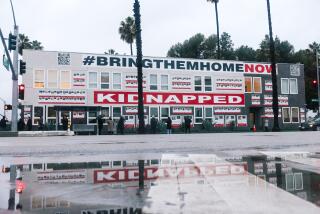Taking a Pasting : Robbie Conal on Receiving End of Satirical Posters
- Share via
Artist Robbie Conal, whose satirical street posters have skewered the likes of Ronald Reagan, Dan Quayle and Jesse Helms, is getting a dose of his own medicine.
In recent weeks, three different Conal-esque posters depicting the artist himself have appeared along streets in Venice and Santa Monica. Some are even pasted over Conal’s pointed take on U.S. Supreme Court Justice Clarence Thomas, the latest edition in a series of posters that savages members of the Supreme Court, each accompanied by a phrase that starts with the words “Gag me.”
The counter-posters are accompanied by texts reminiscent of those that typically accompany Conal’s signature attack art. One, alluding to Conal’s penchant for self-promotion, says “Gag Me With a Press Release.” Another, echoing Conal’s characterization of U.S. Sen. Jesse Helms as an “Artificial Art Official,” says “Artificial Artist.” A third says “Robbie Banal,” with an unflattering depiction of him that has dollar signs in his eyeglasses.
Two of the most visible posters are the work of young artists who say that their friendships with Conal soured during his evolution into art luminary and celebrity. The creator of “Robbie Banal” remains a mystery.
Filmmaker Clay Walker, 24, whose recent documentary “Post No Bills” traces Conal’s rise from unknown satirist to celebrity, created the “Gag Me With a Press Release” poster. The creator of the “Artificial Artist” poster is Patrick Crowley, a former student of Conal’s at Otis/Parsons School of Art and Design, who says he has not received adequate credit from Conal for his collaboration on the artist’s infamous poster of former Los Angeles Police Chief Daryl Gates. Crowley and Walker say they did not collaborate in their efforts, but add that they once ran into each other late at night while putting up the posters.
Walker said he timed his attack to coincide with the opening of Conal’s exhibition at the Koplin Gallery in Santa Monica on Oct. 17.
“The ‘Gag Me’ poster was about how Robbie has become a self-parody,” Walker said. “I think the (street art) he is doing is legitimate, but I criticize his motivation. People need to realize that his No. 1 agenda is to promote his artwork through this pseudo-medium of being a guerrilla artist to become a recognized painter. Nothing wrong with it, but he is doing it by exploiting important issues and walking the line between promoter and political critic.”
Conal, who has worked as an Abstract Expressionist painter most of his life and who has been creating the political posters for the last six years, says that he has been paid as much as $25,000 for a painting, but has been without gallery representation for the last decade. The Koplin exhibition was his first solo show since 1988.
“It’s not like I’m a bomb-throwing Bolshevik,” Conal said. “I’ve been making art for 38 years of my 48 years, and I am not going to say no to someone who is going to show my paintings in a clean, well-lighted place and sell them for as much as they’re worth. I never thought there was a contradiction in showing your work in a gallery and running around like a maniac in the streets putting up your stuff. Sometimes it’s incumbent upon an artist to do both.”
Walker and the co-producer of the “Post No Bills” film, Marianne Dissard, 23, pasted a number of the counter-Conal posters along Santa Monica’s Third Street Promenade and at street corners such as Abbot Kinney and Venice boulevards in Venice, where they covered up Conal’s posters.
Bad manners, says Conal.
“My only objections are to bad guerrilla etiquette,” he said. “I think the posters are funny. I get a kick out of them. I am perfectly willing to be held accountable by the public for my actions and by people with a personal agenda for what I am doing. These people are more than welcome to put up posters next to and surrounding mine. But to obscure my critique of Clarence Thomas and Dan Quayle by postering over our posters is bad guerrilla etiquette to the max. I still happen to think that a sexist like Thomas on the Supreme Court and Quayle, in whatever capacity, are more dangerous to democracy than I am.”
Walker admits that his attack on Conal is largely a personal one. He received an $88,000 grant to produce his film through the Independent Television Service and spent two years tracking Conal, during which time the relationship between filmmaker and subject deteriorated.
“We had a real falling out in terms of communication,” Walker said. “A lot of it had to do with the pressure Robbie was under while we were filming him (getting his work into galleries and doing television interviews) and the fact that we couldn’t pay him for being in the film. That was really greedy on his part.”
In acknowledging that there were problems, Conal said: “I liked the movie and I think they are very talented. I’ve made my share of mistakes with these young people. I was trying to live my life and I had two years of them nipping at me. It was very difficult and very touchy.”
As for the money, Conal said that when he realized that Walker had received a sizable grant for the documentary, he simply wanted a token sum of about $2,000 for his trouble. He said he dropped it when he realized Walker couldn’t spare the money from the budget.
And although Walker says his film is critical of Conal, The Times’ Kevin Thomas did not agree, writing in a review that the “ultimate irony” of the film “is that Conal has achieved both acclaim and notoriety without having to compromise himself.”
Crowley, who made the “Artificial Artist” poster, said the project grew out of his anger at Conal for not adequately sharing credit and profits in the creation of the Gates poster. Both men agree that it was Crowley--while still Conal’s student--who came up with the rough idea for the Gates poster, which has a shooting-gallery target superimposed over a photo of the former chief. The image is accompanied by a quote from Gates saying, “Casual Drug Users Should Be Taken Out and Shot,” with the word “Shot” crossed out and replaced by “Beaten.”
“I finally asked (Conal) to buy me out,” said Crowley, 28. “So he did, for $2,000. Robbie pretty much took all the credit on radio and talk shows, but he did mention me in his book. It looked like I was letting this guy walk all over me and I got sick of it. It’s like the teacher taught the student how to make posters and the student learned and put them up. He taught me well.”
Conal, who gave Crowley full credit as co-creator of the poster in three paragraphs of his autobiography, “Art Attack: The Midnight Politics of a Guerrilla Artist,” said: “The initial deal was that we’d split the profit, but he didn’t realize that we weren’t making any money. And I always bring him up and give him credit for that poster.”
Conal added that he has no control over whether or not news organizations omit Crowley as a co-creator of the poster in the course of editing programs or stories.
In any event, Conal said, the time may be coming for him to leave midnight postering behind.
“In a funny sort of way, I feel like there are many young people out there who are legitimately more angry than I am and it’s their turn to take this over. I can feel myself morphing into a guerrilla video-cyberpunk, and stepping up into an attack on prime time with 30-second videos. I am ready to leave the street to the kids.”
More to Read
The biggest entertainment stories
Get our big stories about Hollywood, film, television, music, arts, culture and more right in your inbox as soon as they publish.
You may occasionally receive promotional content from the Los Angeles Times.










